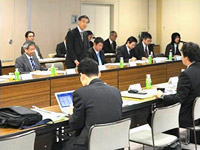| Name/Title | The 8th Japan-Korea Technical Conference on Sediment-related Disaster Prevention | ||||||||||
|---|---|---|---|---|---|---|---|---|---|---|---|
| Venue: Country,City | Japan | ||||||||||
| Date | Dec. 1, 2009 | ||||||||||
| Detail | The Japan-Korea Technical Conference on Sediment-related Disaster Prevention has been held annually in Japan or Korea since 2002, aimed at contributing to sabo administration and technological R&D by exchanging information and opinions on the latest trend of sediment-related disaster prevention in the two countries.
This year’s conference, the “8th Japan-Korea Technical Conference on Sediment-Related Disaster Prevention” was held at the Mita Conference Hall (Tokyo) on December 1, 2009. The conference was started with opening addresses by Sim Young Man, Director of Forest Engineering and Rehabilitation Division of Korea Forest service and Hiroshi Makino, Director General of Sabo Department, Ministry of Land, Infrastructure, Transport and Tourism (MLIT), followed by active discussions on sabo’s multi-purpose aspects, such as the ecosystem, aesthetics, and regional vitalization. The following presentations were made at the conference (Table 1). Table -1 Presentation topics
First presentations from both countries dealt with the present state of sabo administration in each country, including a recent change in sabo budget in Korea. Participants deepened mutual understanding of the current state of sabo projects in the two countries. The Korean side also introduced the outline of the Korea Sabo Association which was recently established based on the Erosion Control Act (enacted in 1962). The aim, organization, and activities of the Association are as follows.
Activities:
After the presentations from both countries, Nobutomo Osanai, Head of the Erosion and Sediment Control Div., National Institute for Land and Infrastructure Management, summarized the achievements of Japan-Korea collaborative study. It was also confirmed that a format containing uniform indices would be prepared as a means to identify the actual state of sediment-related disasters above a certain scale that occur in both countries. At the end of the conference, the delegation leaders signed the minutes and agreed to hold the next 9th conference in Korea in the autumn of 2010.  |